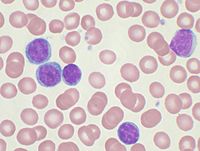
Photo from wikipedia
In an otherwise eligible patient with relapsed lymphoma, inadequate mobilization of hematopoietic stem cells (HSCs) is a limiting factor to proceeding with an autologous hematopoietic cell transplantation (auto-HCT). Multiple strategies… Click to show full abstract
In an otherwise eligible patient with relapsed lymphoma, inadequate mobilization of hematopoietic stem cells (HSCs) is a limiting factor to proceeding with an autologous hematopoietic cell transplantation (auto-HCT). Multiple strategies have been used to mobilize an adequate number of HSCs with no obvious front-line strategy. We report a single institutional experience mobilizing HSCs using four different approaches in lymphoma patients. We prospectively collected mobilization outcomes on patients planned to undergo auto-HCT at Ohio State University. We report results of first mobilization attempts for all relapsed or refractory lymphoma patients between 2008 and 2014. We identified 255 lymphoma patients who underwent mobilization for planned auto-HCT. The 255 lymphoma patients underwent the following front line mobilization strategies: 95 (37%) G-CSF alone, 38 (15%) chemomobilization (G-CSF+chemotherapy), 97 (38%) preemptive day 4 plerixafor, and 25 (10%) rescue day 5 plerixafor. As expected, there were significant differences between cohorts including age, comorbidity indices, histology, and amount of prior chemotherapy. After controlling for differences between groups, the odds of collecting 2 × 106/kg HSCs on the first day of collection and 5 × 106/kg HSCs in total was the highest in the cohort undergoing chemomobilization. In conclusion, our experience highlights the effectiveness of chemomobilization.
Journal Title: Bone marrow transplantation
Year Published: 2017
Link to full text (if available)
Share on Social Media: Sign Up to like & get
recommendations!